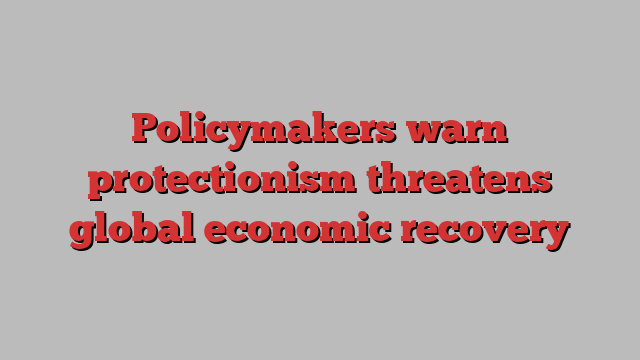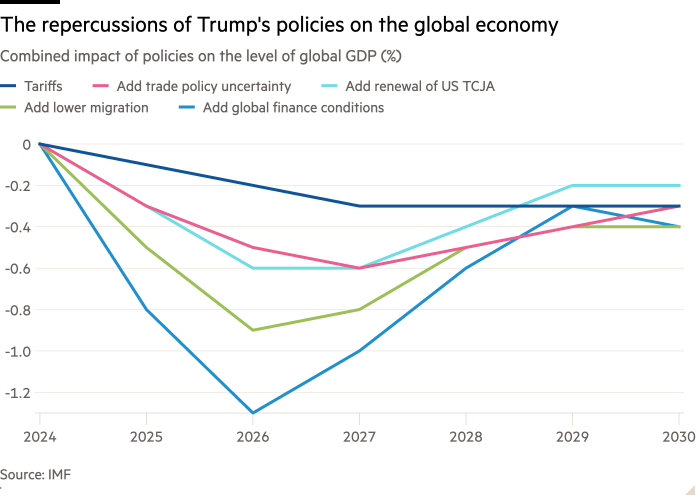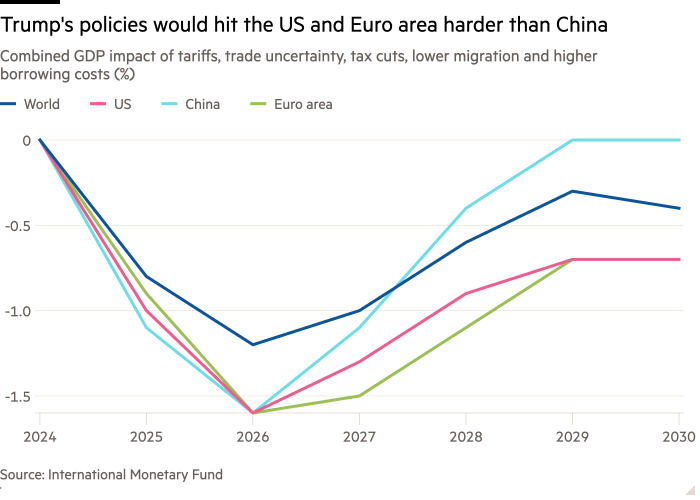
Unlock the Editor’s Digest for free
Roula Khalaf, Editor of the FT, selects her favourite stories in this weekly newsletter.
An “alarming” lurch towards economic protectionism risks derailing the global economic recovery, top officials have warned as the race for the US presidential election enters its final days.
Speaking on the sidelines of the IMF’s annual meetings with the World Bank in Washington this week, officials expressed relief at signs that the global economy is on track for a soft landing, avoiding recession after the worst bout of inflation for a generation.
However, they cautioned that mounting political risks in the US and elsewhere threatened the outlook.
“Any new attempt to reverse globalisation and to retreat into protectionism would be alarming,” Agustín Carstens, general manager of the Bank for International Settlements, told the Financial Times. “This could increase prices, raise unemployment and crimp growth.”
Klaas Knot, the Dutch central bank chief and chair of the Financial Stability Board, the world’s financial watchdog, said he saw “some risk of price corrections” in certain markets given the “contrast” between rising geopolitical risks and current valuations.
Some policymakers fear that the global, rules-based order embodied by the Bretton Woods institutions — which this year mark their 80th anniversary — is at risk of being upended.
With Donald Trump and Kamala Harris neck-and-neck in the polls, the world’s largest economy could next year undergo a dramatic shift in policy.
Trump has pledged to impose across-the-board tariffs of 20 per cent on America’s partners, as well as a 60 per cent tax on Chinese imports, while pursuing mass deportation of undocumented immigrants and sweeping tax cuts.

The IMF has tried to quantify the damage that a tit-for-tat trade war involving tariffs imposed by the US, Europe and China would cause.
It estimated that the global economy is set to expand by 3.2 per cent this year and next — but widespread levies, tax breaks, less migration and higher borrowing costs could hit output by 0.8 per cent in 2025 and another 1.3 per cent in 2026.
Economists at Morgan Stanley expect Trump’s tariff plan to drag down real GDP growth by 1.4 per cent for the US, while boosting consumer prices by 0.9 per cent.
The Budget Lab at Yale University, a policy research centre, estimates a similar growth hit, but a sharper rise in prices. They reckon Trump’s trade measures could cost households as much as $7,600.

Add to that mass deportations, and Mahmood Pradhan, head of global macroeconomics at Amundi Asset Management, warned that the outlook could become more grim.
“If you have a growth impact that is negative and you have a decline in real wages or purchasing power of consumers because prices are higher for their everyday goods, that to me is like stagflation,” he said.
Mounting angst about the outlook came despite broader optimism at the annual meetings about the global success in beating back inflation after the worst shock in decades.
Price pressures appear close to vanquished. Central banks are now engaged in the early phase of their easing cycles, debating how quickly to lower interest rates to a level that no longer stifles growth.
“The trick now is to finish the job on inflation without unnecessarily damaging the job market,” Kristalina Georgieva, head of the IMF, told reporters on Thursday.
Succeeding on that front was crucial at a time when the global economy is “in danger of getting stuck on a low growth, high debt path”, she added.
Global public debt is forecast to exceed $100tn by the end of this year, the multilateral lender estimates, with debt set to approach 100 per cent of global GDP by the end of the decade.
Some attendees fear that financial markets are yet to catch on to the impact of the daunting levels of debt confronting officials across advanced and emerging economies.
Even the US Treasury market — the biggest, most important bond market — could be susceptible to volatility if debt levels continued to rise, said Pradhan, warning of a tailing off in what has long been a robust appetite for the safe haven by foreign investors.
But it was the risk that long-standing relationships could deteriorate into acrimony that was at the forefront of policymakers’ minds on Friday as they prepared to leave Washington.
“This is a challenge for Europe because we are so trade intensive. It could also be a risk for America because any trade difficulties will inevitably have an effect on the price that American consumers pay for their goods,” Paschal Donohoe, president of the Eurogroup, said.
“It has the potential to cause significant uncertainty — and by creating that uncertainty [to] diminish our ability to secure a soft landing that we have all worked so hard for.”